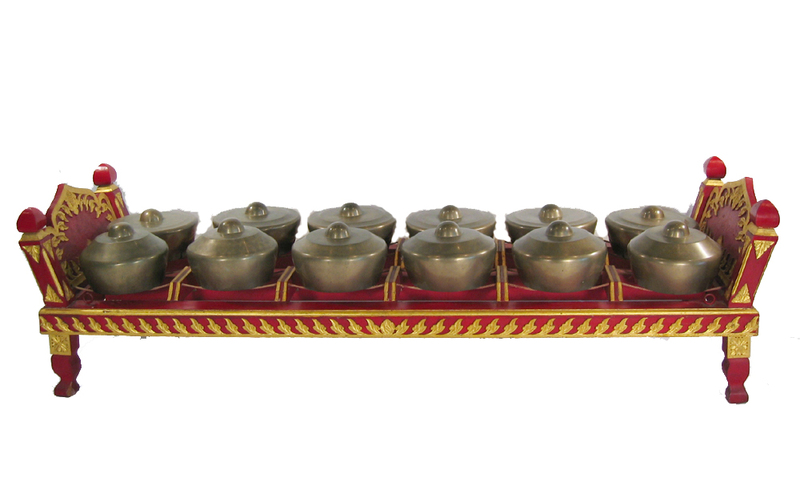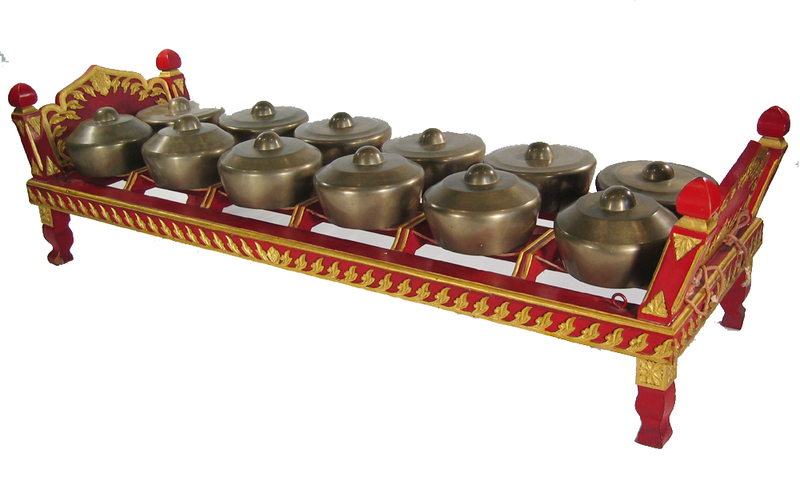Bonang
Title
Bonang
Description
Physical description:
The bonang consists of two rows of horizontal gong-kettles with the open side facing down, which is placed on cords stretched over a rectangular wooden-frame. The bonang is played with two cylindrical sticks, which are padded with cord at the striking end. A full gamelan set has two kinds of bonang: bonang barung and bonang panerus; the latter is one octave higher than the former (its lower octave overlaps with the higher octave of bonang barung). Depending on the tuning system, a bonang may have fourteen gong-kettles for pelog (seven in each row), or twelve or ten for slendro (six or five in each row). Some gamelan may also have bonang panembung, a bonang whose octave range is one octave lower than bonang barung.
Role in the gamelan ensemble:
Bonang barung is one of the leading instruments in the ensemble. The anticipatory nature of its playing technique can be used as a melodic guide for the ensemble in expressing its melodies. Particularly, the playing style known as pipilan (playing single notes one at a time) leads the flow of the melody, and certain gembyangan (octave playing) are used as a sign for melodies in high octave ranges that are unattainable by the saron. There is another bonang playing technique that requires two bonang, bonang barung and bonang panerus, which creates interlocking melodic patterns using a technique called imbal-imbalan.
-Sumarsam, 2004
The bonang consists of two rows of horizontal gong-kettles with the open side facing down, which is placed on cords stretched over a rectangular wooden-frame. The bonang is played with two cylindrical sticks, which are padded with cord at the striking end. A full gamelan set has two kinds of bonang: bonang barung and bonang panerus; the latter is one octave higher than the former (its lower octave overlaps with the higher octave of bonang barung). Depending on the tuning system, a bonang may have fourteen gong-kettles for pelog (seven in each row), or twelve or ten for slendro (six or five in each row). Some gamelan may also have bonang panembung, a bonang whose octave range is one octave lower than bonang barung.
Role in the gamelan ensemble:
Bonang barung is one of the leading instruments in the ensemble. The anticipatory nature of its playing technique can be used as a melodic guide for the ensemble in expressing its melodies. Particularly, the playing style known as pipilan (playing single notes one at a time) leads the flow of the melody, and certain gembyangan (octave playing) are used as a sign for melodies in high octave ranges that are unattainable by the saron. There is another bonang playing technique that requires two bonang, bonang barung and bonang panerus, which creates interlocking melodic patterns using a technique called imbal-imbalan.
-Sumarsam, 2004
Geographic region
Indonesia
Collection
Citation
“Bonang,” Wesleyan University Virtual Instrument Museum 2.0, accessed December 14, 2025, https://wesomeka-test.wesleyan.edu/vim2/items/show/3.

